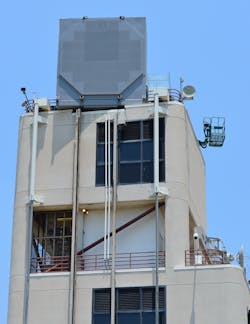Raytheon Takes Contract for Scalable Aircraft Carrier Radars
The contract that Raytheon signed on Tuesday to build new aircraft carrier radars is not especially lucrative. At $92 million, it is just another drop in Raytheon’s bucket of $23 billion in annual revenue.
But it stands out as the latest vote of confidence for inexpensive radars that can be linked together in bunches and customized for different ships. The new radar will replace several older radar systems that were designed to work alone.
Under the United States Navy contract, Raytheon will build the so-called Enterprise Air and Surveillance Radar, which will be used for sensing airplanes, missiles, and other ships from the deck of carriers. According to the Massachusetts-based company, the radars will detect objects at longer distances and better avoid surrounding clutter, like birds.
The Navy is planning to install the radar on Ford-class aircraft carriers, a new series of extremely large ships that are known as “supercarriers.” In addition, older ships will be backfitted with the new radars.
The retrofitting will be simpler than installing standalone radars, thanks to the scalable nature of Raytheon’s design. The defense contractor is building the system around its Air and Missile Defense Radar, or AMDR, arrays. Each one is comprised of individual building blocks called radar modular assemblies, which can be stacked to control aperture size.
Raytheon’s design is another example of the modular radar systems that other defense companies are testing out. Competing for the same contract, Northrop Grumman has also built a scalable radar system, following blueprints it had drawn for ground and fighter jet radars. Lockheed Martin’s DART radar is also modular and can be plugged into older systems to help lower power consumption and increase reliability.
The EASR system will not be first to employ Raytheon’s scalable radars. The company used the technology in its SPY-6(V) radar, which will be installed on the DDG 51 Flight III destroyer in 2019. That version will contain 37 radar modules spread over four arrays, making it sensitive enough to detect an object half the size at twice the distance of the destroyer’s current radar, Raytheon said.
It is advanced in other ways. The radar uses gallium-nitride components, which have higher power density and efficiency than ones based on gallium arsenide, for transmitting and receiving radio waves. It also employs digital beamforming and data processing to steer signals through cluttered environments.
Raytheon first started working on the EASR contract in 2013 with a roughly $386 million contract. The system will replace the rotating SPS-48 and SPS-49 radars on older ships, as well as expensive Dual-Band Radars that Raytheon also developed.
The Dual-Band Radar can function over two frequency bands (S-band and X-band) simultaneously. It is an active electronically-steered array that Raytheon built to track targets in a wide range of altitudes and weather conditions. According to military news site Defense News, the Navy has scaled back its plans for the dual-band system because it is too expensive.
About the Author

James Morra
Senior Editor
James Morra is the senior editor for Electronic Design, covering the semiconductor industry and new technology trends, with a focus on power electronics and power management. He also reports on the business behind electrical engineering, including the electronics supply chain. He joined Electronic Design in 2015 and is based in Chicago, Illinois.

